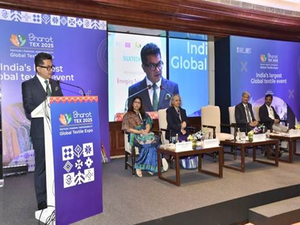New technologies in silk value chain take centrestage at Bharat Tex 2025

New Delhi, Feb 17 (IANS) Union Minister of State for Textiles Pabitra Margherita inaugurated the International Conference on “Emerging Technologies in Silk Sector – SILKTECH 2025” at Bharat Mandapam here on Monday as a part of the mega textile event – Bharat Tex 2025.
The minister highlighted the zero waste technologies in the silk value chain and urged stakeholders to work for achieving the Prime Minister’s target of tripling the production and exports of textiles by 2030 through quality research and collaboration.
Neelam Shami Rao, Secretary, Ministry of Textiles cited the momentous change in sericulture after Silk Samagra and emphasised that the by-products of silk should occupy the mainstream through the next age technologies.
The conference also focused on the discussions and promotion of the novel applications of silk beyond textiles in the field of cosmetics and pharma and the development of appropriate technologies for improving the quality of silk emphasizing global market trends and sustainable innovations across the silk production chain to work for an Atmanirbhar India.
Two souvenir-cum-book of abstracts on emerging technologies in the Silk Sector – SILKTECH 2025 & Pradhyogiki Vivranak (a technology descriptor) were also released by the Minister during the conference.
Various publications of the Central Silk Board were also unveiled on the occasion.
During the conference, six MoUs were signed between R&D Institute of Central Silk Board and its other R&D organisation and NGOs.
In his address, the minister also highlighted the exclusive Muga and Eri silks of the country’s North East region. Muga and Eri silk are indigenous silks of the North East region of India. Assam is the world’s largest producer of Muga silk which is a wild silk produced in the Brahmaputra Valley that is golden in colour and known for its durability.
The silk is used to make saris, mekhalas, and chadors.
Eri silk is produced in Assam, Meghalaya, Nagaland, Mizoram, Manipur, and Arunachal Pradesh. Muga and Eri silk production is important culturally and economically for the North Eastern Region of India and provides large scale employment in the region.
–IANS
sps/pgh




